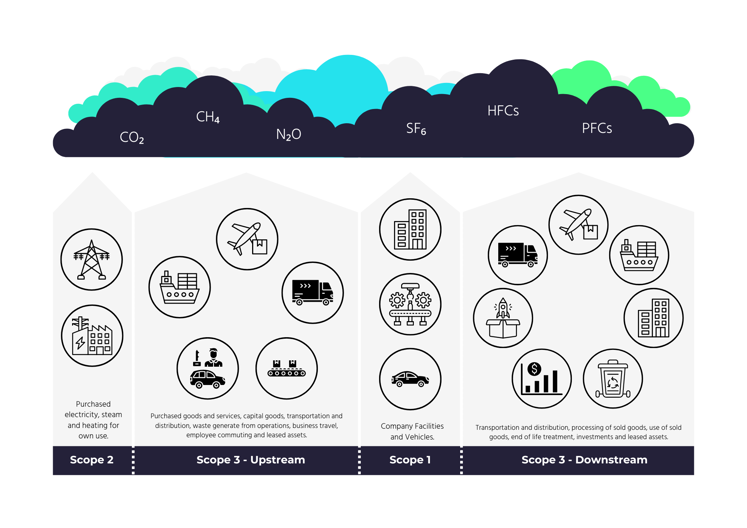Many businesses today are committed to reducing their greenhouse gas (GHG) emissions and recognise their place in participating in the global fight against climate change. Yet, to do this, businesses need to have a sound understanding of their own emissions across their entire value chain. Typically, businesses have good control over their Scope 1 emissions (direct emissions from an organization’s own operations) and Scope 2 emissions (emissions from the electricity, heat, or steam that an organization purchases.) This isn’t the case for Scope 3. Scope 3 emissions are the greenhouse gas emissions (including carbon dioxide, nitrous oxide, and methane) that occur along the downstream and upstream value chain of an organization, from the extraction of raw materials to the end use and disposal of products and/or services. Scope 3 emissions can be overwhelming to report on given the vast array of operations they cover yet given they typically account for 70%-80% of a company’s total carbon footprint it's essential businesses get more accustomed to measuring these emissions and including them in sustainability reports.[1]
The Scope 3 Standard created by the Greenhouse Gas Protocol is “the only internationally accepted method for accounting for these types of indirect emissions”.[2] It provides a framework for identifying and measuring the emissions from upstream and downstream activities, such as purchasing goods and services, transporting, and distributing products, using sold products, and managing waste. By using the Scope 3 Standard, businesses can report and credibly and with greater transparency, communicate their emissions transparently to their stakeholders including customers, investors, regulators, and suppliers (who might want support understanding their scope 1.). [3]
The companion guide provides businesses with practical guidance and tools on how to collect and calculate their activity data and emission factors for each scope 3 category. It also gives examples and case studies of how other companies have implemented the Scope 3 Standard and achieved benefits such as cost savings, risk reduction, innovation, and an enhanced reputation.
Naturally, scope 3 emissions are the most challenging to measure and manage as they involve multiple, often complicated sources and can be a time-consuming process.[4] There are often data gaps that a business can’t bridge without data driven carbon reports from suppliers. Getting suppliers to agree to this level of data sharing and transparency can be tricky if they lack the motivation or resources to provide the necessary information. The general uncertainty of trying to manage emissions from operations outside a company’s control can be overwhelming when trying to ensure your scope 3 is as accurate as possible.[5] Despite the little direct influence, Scope 3 emissions can be effectively managed.

Measuring scope 3 emissions is important for businesses because it can help them understand the full extent of their environmental impact by identifying emission hotspots in their supply chain and from here recognise opportunities to improve. These opportunities and recommended amendments can then be communicated to stakeholders to drive engagement in their sustainability performance, hopefully leading to sustained business growth. Measuring scope 3 emissions can benefit businesses in several ways:
Businesses can bring down costs as well as risks by homing in on inefficiencies and vulnerabilities in their value chain.[6] With the knowledge of the weak conservational processes in their supply chain, businesses can better anticipate and respond to regulatory, market, and reputational pressures. The guesswork can be taken out and replaced with good data that can drive the appropriate business decisions for superior sustainability performance.
For example, by measuring the emissions from their transportation activities, businesses can optimize their logistics (plan more direct routes), look at methods to decrease fuel consumption and switch to lower-carbon modes of transport.[7] Companies can also assess the environmental performance of their procurement practices, and work with their suppliers to improve their efficiency and quality by measuring the emissions from their suppliers. Moreover, they can understand the impact of their products and services on the end users, and design solutions that reduce waste and increase customer satisfaction by measuring the emissions from their customers.
Showing their commitment to climate action by disclosing their emissions transparently, and engaging with their stakeholders on sustainability issues, businesses can enhance their reputation and credibility. For instance, they can demonstrate awareness of the environmental impact of their travel choices when travelling for business purposes and make a public commitment to improve upon their baseline. This could look like implementing companywide incentives to encourage low-carbon travel options such as working from home or extra budget put aside for a social fund if a low-carbon commute like public transport, walking, cycling, or carpooling is elected over the regular, higher-carbon commute.
They can also show their responsibility for the disposal of their waste materials and adopt strategies that promote recycling and a circular economy by measuring the emissions from their waste management. Furthermore, they can align their financial decisions with their sustainability goals, and support projects that contribute to climate mitigation and adaptation by measuring the emissions from their investments.
Creating competitive advantages, fostering innovation, and meeting the expectations and demands of their customers and investors are some of the benefits that businesses can gain by measuring scope 3 emissions.[8] For instance, they can differentiate themselves from their competitors by offering low-carbon products that meet the needs and preferences of their customers by measuring the emissions from their product use.[9] They can also stimulate innovation by exploring new technologies and solutions that reduce their environmental impact by measuring the emissions from their research and development. In addition, they can attract investors who are looking for sustainable investments that generate long-term value by measuring the emissions from their capital goods.
Therefore, measuring scope 3 emissions is not only a responsibility but also an opportunity for businesses to create value, achieve their sustainability goals and align with the global fight against climate change by aligning to the United Nations Sustainable Development Goals.
In the next blogs we will discuss the 15 categories in Scope 3 and how the NHS are managing their Scope 3 emissions, a tricky feat with over 80,000 suppliers.

References
[1] Deloitte (2022) Explained: What are Scopes 1, 2 and 3, Deloitte United Kingdom. Available at: https://www2.deloitte.com/uk/en/focus/climate-change/zero-in-on-scope-1-2-and-3-emissions.html.
[2] Corporate Value Chain (Scope 3) Standard, GHG Protocol. ghgprotocol.org. Available at: https://ghgprotocol.org/corporate-value-chain-scope-3-standard.
[3] Corporate Value Chain (Scope 3) Standard, GHG Protocol. ghgprotocol.org. Available at: https://ghgprotocol.org/corporate-value-chain-scope-3-standard.
[4] Bernoville, T. (2022). What are Scopes 1, 2 and 3 of Carbon Emissions? [online] Plana.earth. Available at: https://plana.earth/academy/what-are-scope-1-2-3-emissions.
[5] Carbon Trust (2019). Briefing: What are Scope 3 emissions? [online] https://www.carbontrust.com/our-work-and-impact/guides-reports-and-tools/briefing-what-are-scope-3-emissions. Available at: https://www.carbontrust.com/our-work-and-impact/guides-reports-and-tools/briefing-what-are-scope-3-emissions.
[6] DiVito, C. (2022). How To Measure Scope 3 Emissions. [online] FigBytes. Available at: https://figbytes.com/blog/how-to-measure-scope-3-emissions/ [Accessed 4 Sep. 2023].
[7] IMB. What are scope 3 emissions? IBM. Available at: https://www.ibm.com/topics/scope-3-emissions (Accessed: 04 September 2023).
[8] An introductory guide to scope 3 emissions (2023) The Carbon Trust. Available at: https://www.carbontrust.com/our-work-and-impact/guides-reports-and-tools/an-introductory-guide-to-scope-3-emissions (Accessed: 04 September 2023).
[9] Trucklabs (2023) Scope 3 emissions: What you need to know in 2023, TruckLabs. Available at: https://www.trucklabs.com/blog/scope-3-emissions/ (Accessed: 04 September 2023).
Written By Charlie Dawson
